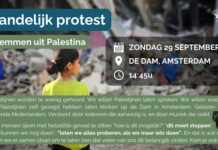Tareq S. Hajjaj
Mondoweiss / June 28, 2024
Israel has been forced into a war of attrition as the Palestinian resistance has reconstituted itself across Gaza. The scale of the horrors perpetrated by the Israeli army in these battles only emerges through testimonies after the fighting ends.
It was noon on June 26 when the residents of the Al-Shuja’iyya neighborhood east of Gaza City — one of the largest neighborhoods in the Gaza Strip inhabited by over 300,000 people — were taken by surprise as Israeli tanks rolled into their neighborhood.
Residents described chaotic scenes as tanks fired indiscriminately, unleashing a barrage of shells that ripped through the area. Many hastily gathered their essentials into bags that they had prepared in anticipation of yet another round of displacement. Within hours, videos and photos circulated showing thousands fleeing in panic, fear, and tears.
Arwa Awais, 22, who had given birth to her baby in her home on Al-Mantar Street, recounted seeing her husband spring into action when he saw the tanks approaching about 300 meters away from their home. They grabbed what they could and headed to the Sabha Hospital.
“I was unaware of what I was doing,” she told Mondoweiss. “I put my baby daughter’s supplies in a bag, carried them, and we went out into the street without wearing appropriate clothes or putting our shoes on our feet.”
Having endured multiple displacements in previous months, and knowing the horrors of which Israeli ground forces were capable from previous massacres in the north, Arwa knew that staying was not an option. She joined her sister Lina from al-Nazaz Street, and together they sought refuge with a third sister in the western outskirts of al-Shuja’iyya.
When the three sisters met, they decided to completely evacuate al-Shuja’iyya. The third sister who hosted them was also looking for another place to go with her family until the incursion began to wind down. They considered areas west of Gaza City, or they risked going south and not being able to return.
That night, the majority of families in the Shuja’iyya neighborhood left their homes and slept in the streets, carrying everything they owned on their backs.
Arwa, moving westward across Al-Shujaiya, witnessed neighboring houses being shelled, but by some miracle she and her loved ones survived even as the buildings and streets around them were hit.
“All the way I was looking at the face of my two-month-old daughter,” she said. “Despite the scenes of death and the body parts piled on top of each other from the drones that targeted fleeing residents, I was only thinking about one thing, which is that I was carrying my daughter and moving her from one area to another for the third time in her short life. I thought it can’t be fair for a child to witness all these scenes and hear all these sounds.”
“We are not running away from death,” Arwa explained. “We have died several times already throughout the course of this war, waiting for it to stop. Our hearts have become charred by what we have lived through. But if we have the freedom to choose, we do not want to die under the rubble. We don’t want stray dogs to eat my daughter’s body, because this is what happens when any area is invaded by the Israeli army in Gaza. Corpses are left in the streets and under the rubble, until dogs eat them.”
Arwa said that when people ask her how old her daughter is, her answer is different every time. “I tell them that my daughter Malak survived tens of thousands of shells and missiles, and that is her age,” she said.
The Gaza health ministry said in its daily casualty report that during the past 24 hours, the Israeli army had killed 47 people in Gaza and 52 more were injured.
Following the Israeli withdrawal from Al-Shuja’iyya two months ago, many families had returned to their damaged homes and tried to resettle amid the ruins, only to face this latest renewed invasion without warning.
The Israeli military’s surprise assault targeted not only the area surrounding Sabha Hospital but also Al-Shuja’iyya at large, including its different sprawling sectors like Al-Turkman, Al-Tuffah, al-Sha’af, and Al-Nazaz.
The Israeli army did not give the civilians any warning ahead of the launch of its operation, instead using the element of surprise to storm the area with a large ground force. According to testimonies gathered by Mondoweiss from neighborhood residents, everyone was surprised by the sudden incursion.
Only several hours after the raid had begun did the Israeli army drop leaflets and make phone calls to residents, ordering them to leave the Shuja’iyya neighborhood and head south. According to residents’ testimonies, the Israeli army surrounded the area and deployed very quickly.
Eyewitnesses said that the small Sabha Maternity Hospital became a refuge for families, the majority of whose members were exterminated because they had family members who were affiliated with the Hamas movement. Those who survived took refuge in the hospital after all their homes were destroyed and most of their relatives were killed.
This recurring pattern of incursions aims to quash resistance, having previously decimated Al-Shuja’iyya in prior operations. Despite widespread destruction, residents persist in rebuilding and resisting, insisting on returning to live among the rubble of their homes.
‘Mowing the lawn’ as war of attrition
By now, a pattern has emerged in how the Israeli army operates in areas from which it had previously withdrawn after having “cleared” the resistance there. The army launches a surprise attack, kills indiscriminately, arrests people en masse, surrounds neighborhoods and inspects them house by house, and all the while engages in battle with resistance fighters that attempt to lead the invading forces into ambushes. When searching and raiding a home, arrest or execution is carried out immediately.
This all lasts for several days, sometimes weeks, and the testimonies of the scale of the horrors perpetrated by the Israeli army only emerge after its activities have concluded.
Following its withdrawal, the army continues to monitor the area for protracted periods, returning to it to test the resistance’s ability to reconstitute itself in that area and confront the army again. Yet every time, the resistance demonstrates a resilience and versatility that has continued throughout months of the ground invasion.
This is what the Israeli army did when it invaded Al-Shifa Hospital in March for a second time since the start of the war, laying siege to the medical compound and its vicinity for two weeks and completely destroying it. Survivor testimonies described how Israeli soldiers rounded up patients and medical staff and executed them alongside Gaza civil servants and displaced refugees in a large massacre before burying them in mass graves.
The same pattern repeated itself when the army re-invaded Jabalia and Jabalia refugee camp in mid-May, spending three weeks engaging in battle with resistance fighters in the camp’s alleyways before eventually withdrawing.
The same is now happening in Al-Shuja’iyya, and the results are likely to be the same. The Israeli army’s strategy has become clear, seeking to “mow the lawn” wherever resistance pops back up in Gaza as the fighting winds down from its “intensive phase,” as Prime Minister Benjamin Netanyahu said four days ago.
But there is a more accurate way to describe this dynamic — it is a war of attrition with the resistance.
During the first hours of the invasion of Shuja’iyya, the resistance factions announced their defensive operations against Israeli forces, including the destruction of tanks and troop carriers and the targeting of groups of soldiers.
The invasion has barely surpassed 24 hours, yet as of the time of writing, initial reports have begun to emerge of heavy Israeli casualties in Shuja’iyya.
Tareq S. Hajjaj is the Mondoweiss Gaza Correspondent, and a member of the Palestinian Writers Union












